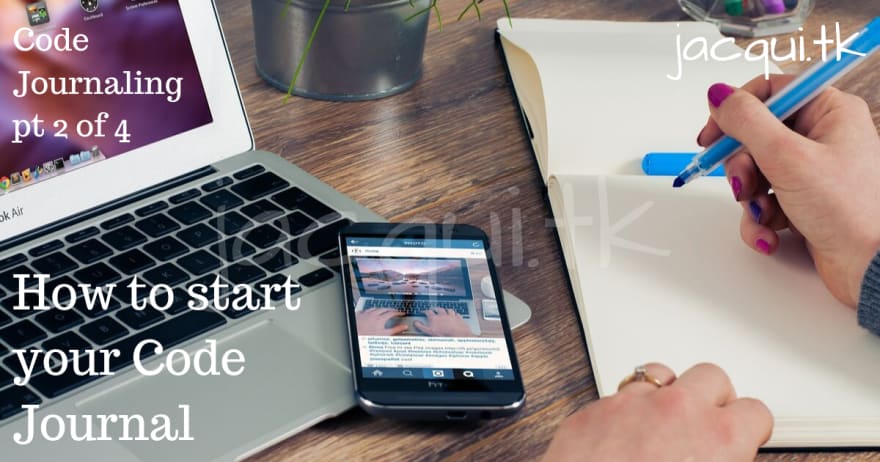In this second post in my series on Code Journaling, I will cover how to start your own Code Journal.
Choose your medium
The medium of your Code journal is an important decision. Just as the content will be individual to you so will your preference for analogue or digital, and the exact choice of a medium within those categories.
Some people may already use a notebook (analogue) and some may be full converts to using Evernote (digital) for everything they do. Here are a few pros and cons of each category and some non-exhaustive options for each:
Analog is more beautiful than digital, really, but we go for comfort.
Anton Corbijn
Analogue
This category covers everything that does not require something like a phone, tablet or computer to access (i.e. no electricity).
Pros
- You slow down and think about what you are writing.
- You can’t be hacked or lose data.
- Writing stimulates and engages your brain better, and has been shown to produce more content, expressing more ideas, and faster than typing. 1
- It gets you away from your screen!
Cons
- If you lose it there is no backup (unless you make a copy).
- It’s only accessible wherever the physical copy is.
Analogue Options
B5 dotted notebook
I find this a good size for a Code Journal, not too small, but enough space and not bulky. Dotted paper is the most flexible as you can use it to easily write lines of text, create tables or draw diagrams. I personally use this ZenArt notebook, but their newer version is linked to above.
A5 dotted notebook
Smaller for those who want to save weight or space, or maybe your small handwriting gets lost in a larger notebook. Again, I recommend dotted, but it is up to you. I have personally used a Scribbles that Matter dotted notebook for other projects.
A4 dotted notebook
For those who want more space on a page. Moleskine produces an extra-large dotted notebook, which I have heard good things about.
A notebook with removable pages or a folder and paper pad
If you like to move your content around to organise it then these options are for you (although I will tell you all about using an index, which negates the need for moving things around, later on).
Digital
There are lots of digital options, some on specific physical devices and some in the cloud, accessible wherever you are. You are probably already using several digital notebooks.
Pros
- Can be accessible from more than one place.
- Easy to back up.
- Quick to search.
- Can make it easier to stick with the habit of keeping a journal, of any kind.
Cons
- If your account is hacked you could have data stolen or lose it altogether.
- There are a lot of distractions when using a digital device (email, Facebook, etc).
Digital Options
Evernote
Great for organising your coding journal, and can be used for other things at the same time by having multiple notebooks. Searchable via text and tags and heavily customisable.
WordPress blog
Self-host or use WordPress.com. You are in control of whether a post is public or private. There are lots of plugins for heavy customisation.
Diaro
Available online, on Android, on iOS and on amazon. A very flexible diary app. Other similar apps are available, but this is the one I have used.
A Word, Google Doc, or another similar online document
Create a system that works for you in Office Online, Google Docs, Zoho, or similar, using a folder structure and appropriate types of file.
My Preference
For my Code Journal, I currently use a ZenArt B5 dotted notebook. I find the size to be about right for what I want to do with it, and it is good quality and good value for money. The dotted paper is flexible to writing, tables or drawing. (There is now a new version of this notebook)
I use a Main Index and Section Indexes, so I can find things easily. It gets me away from a screen and allows me to slow down, disconnect and let the writing flow.
What next?
In my next post in this series on Code Journaling, I will look at what to actually write in your Code Journal.
Originally published at http://www.jacqui.tk/blog on September 16, 2019.









Top comments (7)
Notion (notion.so) is also a great tool for going digital... I use it to keep track and save notes from the books, articles and tutorials I read. It works really nice for me :)
I hadn't heard of Notion.so, I will take a look, thanks.
I would also recommend using OneNote, it is really cool and simple to use on multiple devices, and It's free. I use it on my laptop which has a touch screen, and it's fun to take notes in there.
Notion is another excellent alternative
Thanks for the recommendation, I will take a look.
I use DayOne for my journaling for a long time. I think it's similar to Diaro. It has support for multiple journals, so you can keep code separate from our main one.
I have heard of Day one, another good digital option.